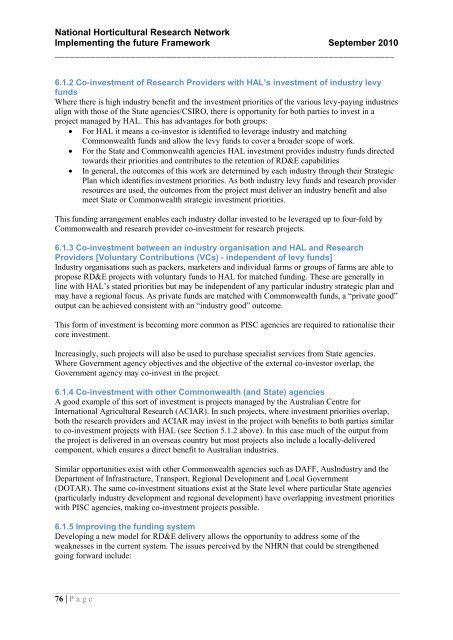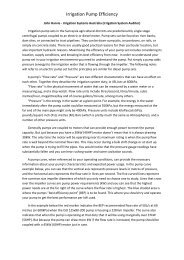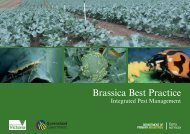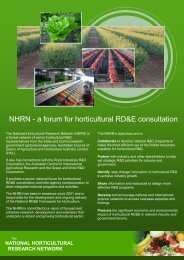National Horticultural Research Network - Horticulture Industry ...
National Horticultural Research Network - Horticulture Industry ...
National Horticultural Research Network - Horticulture Industry ...
You also want an ePaper? Increase the reach of your titles
YUMPU automatically turns print PDFs into web optimized ePapers that Google loves.
<strong>National</strong> <strong>Horticultural</strong> <strong>Research</strong> <strong>Network</strong><br />
Implementing the future Framework September 2010<br />
___________________________________________________________________<br />
6.1.2 Co-investment of <strong>Research</strong> Providers with HAL’s investment of industry levy<br />
funds<br />
Where there is high industry benefit and the investment priorities of the various levy-paying industries<br />
align with those of the State agencies/CSIRO, there is opportunity for both parties to invest in a<br />
project managed by HAL. This has advantages for both groups:<br />
For HAL it means a co-investor is identified to leverage industry and matching<br />
Commonwealth funds and allow the levy funds to cover a broader scope of work.<br />
For the State and Commonwealth agencies HAL investment provides industry funds directed<br />
towards their priorities and contributes to the retention of RD&E capabilities<br />
In general, the outcomes of this work are determined by each industry through their Strategic<br />
Plan which identifies investment priorities. As both industry levy funds and research provider<br />
resources are used, the outcomes from the project must deliver an industry benefit and also<br />
meet State or Commonwealth strategic investment priorities.<br />
This funding arrangement enables each industry dollar invested to be leveraged up to four-fold by<br />
Commonwealth and research provider co-investment for research projects.<br />
6.1.3 Co-investment between an industry organisation and HAL and <strong>Research</strong><br />
Providers [Voluntary Contributions (VCs) - independent of levy funds]<br />
<strong>Industry</strong> organisations such as packers, marketers and individual farms or groups of farms are able to<br />
propose RD&E projects with voluntary funds to HAL for matched funding. These are generally in<br />
line with HAL‟s stated priorities but may be independent of any particular industry strategic plan and<br />
may have a regional focus. As private funds are matched with Commonwealth funds, a “private good”<br />
output can be achieved consistent with an “industry good” outcome.<br />
This form of investment is becoming more common as PISC agencies are required to rationalise their<br />
core investment.<br />
Increasingly, such projects will also be used to purchase specialist services from State agencies.<br />
Where Government agency objectives and the objective of the external co-investor overlap, the<br />
Government agency may co-invest in the project.<br />
6.1.4 Co-investment with other Commonwealth (and State) agencies<br />
A good example of this sort of investment is projects managed by the Australian Centre for<br />
International Agricultural <strong>Research</strong> (ACIAR). In such projects, where investment priorities overlap,<br />
both the research providers and ACIAR may invest in the project with benefits to both parties similar<br />
to co-investment projects with HAL (see Section 5.1.2 above). In this case much of the output from<br />
the project is delivered in an overseas country but most projects also include a locally-delivered<br />
component, which ensures a direct benefit to Australian industries.<br />
Similar opportunities exist with other Commonwealth agencies such as DAFF, Aus<strong>Industry</strong> and the<br />
Department of Infrastructure, Transport, Regional Development and Local Government<br />
(DOTAR). The same co-investment situations exist at the State level where particular State agencies<br />
(particularly industry development and regional development) have overlapping investment priorities<br />
with PISC agencies, making co-investment projects possible.<br />
6.1.5 Improving the funding system<br />
Developing a new model for RD&E delivery allows the opportunity to address some of the<br />
weaknesses in the current system. The issues perceived by the NHRN that could be strengthened<br />
going forward include:<br />
76 | P a g e






